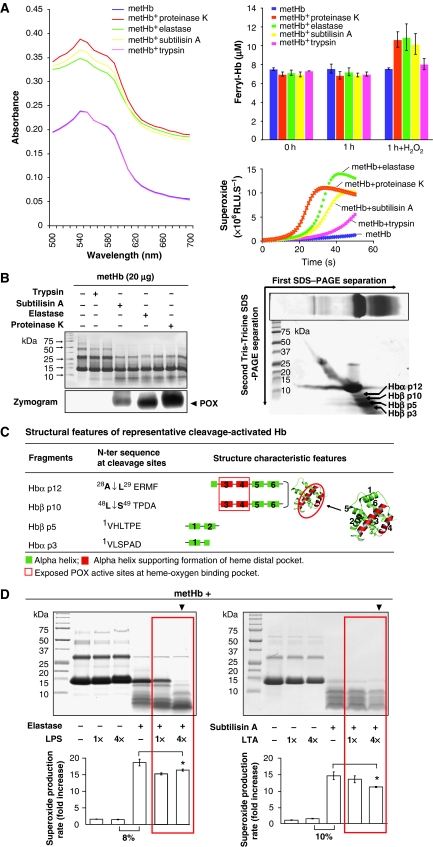Figure 1.
The microbial proteases and PAMPs regulate the Hb-POX cycle activation. (A) Left panel: the absorption spectra of ferryl-Hb intermediate of the partially proteolysed metHb by the microbial proteases (on addition of H2O2). The metHb alone or metHb treated with trypsin (a control mammalian host protease) served as negative controls. Right upper panel: the concentration of ferryl-Hb produced on the addition of H2O2 was further determined by reaction with 2 mM sodium sulfide (Na2S) to form sulphhaemoglobin, which was detectable at 620 nm. Right lower panel: the simultaneous production of superoxide was determined by CLA-CL assay. (B) Left panel: the partial proteolytic profile of metHb was resolved on Tris–Tricine SDS–PAGE (10%). metHb treated with microbial proteases were electrophoresed in duplicate lanes. The POX cycle activities were visualized by chemiluminescence-aided zymography. Right panel: the cleaved metHb fragments were further resolved by second dimensional Tris–Tricine SDS–PAGE. The ‘first SDS–PAGE' (framed) shows the separation of cleaved metHb on an SDS–PAGE gel following which the lane of protein bands was excised and overlaid on the second SDS–PAGE gel for second dimensional separation of each protein band. The protein of interest was identified by MS. (C) The confirmed cleavage sites in metHb, and the structural features in the Hb fragments. The protein structures of Hb α, β subunits and the activated fragments were modelled (Supplementary Data). (D) Dose-dependent proteolytic activation of Hb-POX cycle by PAMPs. The profile of cleaved metHb is shown on Tris–Tricine SDS–PAGE and the Hb-POX cycle activity was quantified based on the production of superoxide by CLA-CL assay. ‘4 × ' is 1:4 molar ratio of metHb:PAMP. The rate of superoxide production was calculated from the linear portion of the CLA-CL curve. The fold increase was obtained by normalizing the data against the negative controls (metHb without treatment). Red boxes highlight progressive cleavages, disappearance of larger intermediate fragments and marginal reduction in the superoxide production in the presence of LPS or LTA.

